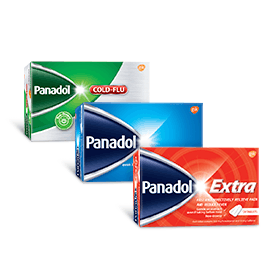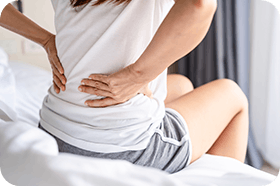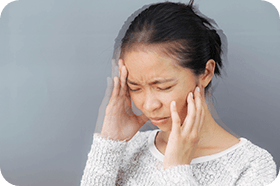Many women experience painful periods once a month. Usually, the pain subsides over the course of the periodxviii but you can take pain medication if the discomfort keeps you from going about your day.
How To Deal With Period Pain?
A painful menstrual cycle is incredibly common. Around a fifth of women experiencing mild menstrual pain, while slightly less than half get moderately painful periods and nearly another fifth report severe painii.
Painful periods can affect women of all ages, though the younger you are, the more likely you are to get them. Three-quarters of women under the age of 25 report menstrual paini.
Period pain can include cramping, back pain, and an irritable mood.
But what is a period exactly? What kind of period pain medication is the most effective? And is Panadol good for period pain?
It’s important to know that, although it’s an annoyance, period pain is a natural occurrence in many women. Even so, period pain can disrupt your day-to-day life, so it’s good to understand how to manage this pain.
Below you can read about what causes the condition, and how to relieve period pain.

What are the top three symptoms of period pain?
Painful periods can be an unpleasant fact of life for those of child-bearing age, though some women say they disappear after having children, while others don't get them at all. Everyone is different.
These are top 3 symptoms of period painxix:
1. Period cramps
2. Lower back pain and/or headaches
3. Nausea and general feeling of being unwell
What other symptoms can I expect during menstruation?
Menstruation symptoms vary among women.
Apart from period pain you may also experience these symptomsxx:
- Depressed mood
- Back pain
- Headaches
- Gastrointestional issues like bloating
What are menstrual cramps?
Menstrual cramps are often described as a throbbing or cramping sort of pain in the lower abdomen. Most cramping occurs before you start to bleed, but it can continue for a few days thereafter.
During a period, the muscles of the uterus tighten and relax to help the tissue lining that has built up in the past the month detach and flow out of the body. You might not notice these contractions or might feel only mild discomfort. Or you might feel them as painful cramps.xxi
The main symptoms of menstrual cramps include:
- Throbbing or cramp-like pain in the abdomen
- Dull aches
- Pain that radiates into the back
The pain usually lasts 24 to 78 hours.
Though the pain is annoying and can disrupt your normal day-to-day activities. With a bit of self-care and pain medication, most women are able to deal with it well.
What is premenstrual syndrome?
Premenstrual syndrome is a combination of physical and emotional symptoms that may affect the majority of women up to a week before they get their period.
Menstrual pain is not the same as premenstrual syndrome, but the two often go hand-in-hand. Premenstrual syndrome can start as early as one week before you get your period. Some 90% of women report having symptomsiii.

There is no test for premenstrual syndrome, but when you notice any combination of the following up to a week before your period, it’s like that what you’re experiencing is premenstrualvi syndromexxii:
- Tender or swollen breasts
- Diarrhoea
- Constipation
- Bloating
- Irritability
In contrast to period pain, the condition is also marked by a variety of mental signs:
- Fatigue
- Tiredness
- Sleep problems
- Anxiety
- Depression
- Mood swings
- Reduced interest in sex
- Food cravings

What causes period pain?
The causes of painful menstruation differ depending on the type of period pain. There are two kinds: primary and secondary period pain.
What is a period?
Each month, your womb (uterus) builds up a layer of its inner lining in preparation for hosting a baby. If you’re not pregnant, your body breaks down and replaces this lining of tissue and blood every 28 days or so. This timing can vary from person to person. This is what's known as ‘a period’ (or menstruation), and is a normal part of your menstrual cycle.
The uterus contractions (or squeezing) that help remove the layer can cause period cramps for one or more days. It's thought that some women produce more prostaglandins, the contraction-triggering chemicals in your body, making the womb squeeze harder, which in turn increases the painiv.
You may experience cramping pain in your lower abdomen, but also in the lower back or thighs.
While this is an experience many women share, if you notice particularly heavy bleeding, very severe cramps, or pain between periods, consult a healthcare professional.
There are two types of period pain:
Primary period pain
Primary period pain is the most common kind of pain that is not caused by another condition. It’s when the muscles in the uterus contract. These contractions cause menstrual cramps.
Secondary period pain
Secondary period pain doesn’t start until much later in life and is caused by conditions like endometriosis or uterine fibroids. Endometriosis affects the lining of a woman’s uterus. It can leave you with very painful cramps during menstruation.
Other symptoms includes pain during or after sex and very heavy bleeding during and between periods.
Can you have menstruation pain without a period?
If you notice cramping and pain around the pelvis but without getting your period it could be a sign of another condition. Among the most common reasons for period pain without bleeding are:
1. Irritable bowel syndromeviii, which can result in stomach pain and bloating or constipation.
2. Crohn’s diseaseix can irritate your digestive tract and lead to changes in your bowel movement.
3. Ovulationx sometimes causes cramps around two weeks after your period. These cramps are uncomfortable but often harmless.
4. Ovarian cystsxi can cause severe pain that extends toward the back and thighs.
5. Pelvic inflammatory diseasexii is a bacterial infection that is spread through sexual intercourse.
6. Cystitisxiii is a bladder infection and this may also cause cramping and pain around the pelvis.
7. Appendicitisxiv is a medical emergency. It produces pain around the belly button that radiates toward the sides of the stomach. Cramps are usually severe.
8. Pregnancyxv and miscarriagexvi could also cause cramping.
You should call a doctor if you get cramps that are very severe, aren’t linked to your period, or that don’t go away after a few days.
How to reduce period pain
Although there is no cure for painful periods, there are plenty of strategies to help make you feel more comfortable—from menstrual pain tablets to hot water bottles. Find out how to abolish the pain quickly.
Period pain can disrupt your day-to-day activities and depending on severity some women even have to take a day off from work. In most cases, the pain should stop after 3 daysv.
To relieve cramping, you can take an over-the-counter period pain medication like Panadol Extra. The combination of ingredients (paracetamol and caffeine) in Panadol Extra provides up to 37% more potent pain relief than standard paracetamol.
Alternatively, you can opt for ibuprofen or naproxen which reduce the amount of prostaglandins in your uterusvii.
You can also try different home treatment strategies to feel more comfortable during your menstrual cycle.
1. Use a hot water bottle or heating pad on your pelvis or back
2. Take a warm bath
3. Massage your abdomen
4. Adopt lifestyle changes such as regular exercise to boost your immune system and wellbeing
5. Practice yoga and mindfulness to relax
6. Eat a balanced nutritious diet for a better immune responsexvii
7. Avoid consuming too much alcohol, caffeine or sugar
If the pain persists, try Panadol Extra, as it’s indicated to fight six types of tough pain, including period pain.
It’s best to seek emergency medical help if you notice:
- A fever
- Severe pain around the pelvis that doesn’t go away
- Odd-smelling vaginal discharge
Is Panadol good for period pain?
The active ingredients in Panadol Extra treat period pain and Panadol Extra provides more effective period pain relief than standard paracetamol tablets.









